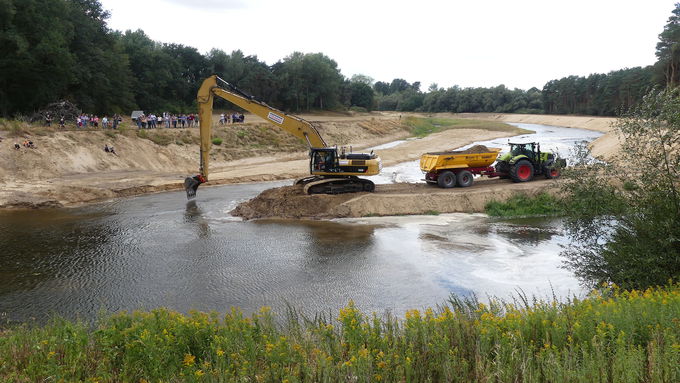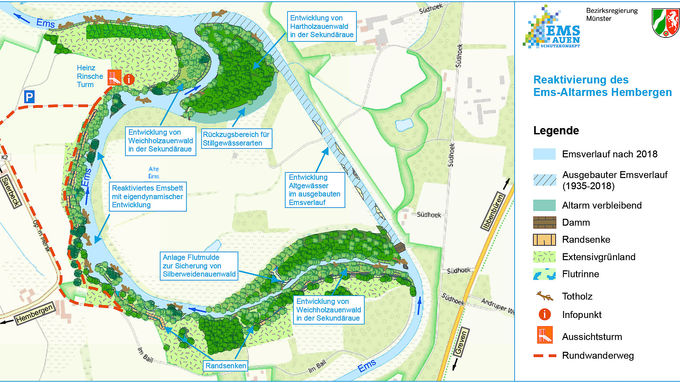Successful step toward renaturation: The Ems backwater near Hembergen is reconnected with the river Ems. © Bezirksregierung Münster
download picturemain content
Project of the month
#9/2018 Complementary Actions and Funds
Renaturation of the river Ems near Hembergen
The LIFE IP ‘Atlantic Region DE’ is the first integrated project in Germany within the LIFE priority area ‘Nature and Biodiversity’. The Integrated LIFE projects were introduced by the European Commission in 2014 to improve the implementation of environmental and climate policies as well as their integration into other programmes. They implement strategies or programmes which are required by EU legislation on a large scale (regional, national or transnational). Integrated nature projects aim to implement the Habitats Directive and effectively manage the Natura 2000 sites. The strategic planning instruments are the Priority Action Frameworks (PAF), which are defined for each programme period at national and / or regional level.
For LIFE integrated projects, funds from other funding sources must also be included. Therefore, an important aim of the LIFE IP ‘Atlantic Region DE’ is to implement the project objectives by complementary funds, for example EU funds such as ERDF or EAFRD, funding programs of the federal states or other national and private funding sources, and to create added value through this additional funding.
While measures for sand habitats and their plant and wildlife species are being implemented in the framework of the LIFE IP ‘Atlantic Region DE’, the complementary actions will supplement the list of improved habitat types and species and will contribute to the implementation of further EU directives (e.g. the Water Framework Directive). As the first major complementary action, the reactivation of an Ems backwater by the Department 54 of the district government of Münster can be presented here in more detail.
Renaturation of the river Ems near Hembergen (district of Steinfurt)
This complementary action aims to improve the hydro-morphological state of the river Ems in the upper section of North Rhine-Westphalia and thus both the structural diversity and the conservation status of aquatic and floodplain habitat types.
In October 2016, the project to redevelop the previous Ems floodplain landscape at Entrup between Hembergen (Emsdetten) and Saerbeck in the district of Steinfurt started. In August 2018, the final cut was made to reactivate the backwater which had been separated in 1935 as part of the Ems development. With this action, the course of the river is now extended by about 1,000 metres and a secondary floodplain up to 90 metres wide was created. The route largely follows the course of the previous backwater. For reasons of nature conservation, the intake area has been completely rebuilt, as one of the last remaining white willow floodplain forests of the Ems floodplain had developed in the silted former runway over the past 80 years. Also in the outlet area, for various technical considerations, a completely new riverbed on state-owned land was constructed. Since the Ems had buried deep into the landscape by straightening and embankment fortification, around 500,000 cubic metres of sand had to be moved to create an almost natural flood regime on the public areas while retaining flood protection for the private owners. The former, straight waterway, which is 1,300 metres long, was maintained as a discharge flume for floods and as a future ‘backwater’. A lot of space is left for the development of standing water bodies via transverse basins, floodplain waters and the remaining 360 metres long backwater remains. Remaining grassland areas will be used extensively as a mowing meadow in the future. In addition, an island of approximately 4.5 hectares was created, which will not be used in any way or be subject to any human intervention. Thus, with the total cost of around six million euros this action did not only result in the connection of one backwater, but also created additional retention area, promoted the development of an alluvial forest and allows for the extensification of a floodplain.
In addition, further measures to implement the Water Framework Directive with similar target species and habitat types are being planned in the area of the river Ems. By the year 2026, measures are planned on around 30 kilometres of the course of the river in North Rhine-Westphalia according to the stepping stone and beam origin concept. These measures have a financial volume of about 30 million euros.
Through these various actions, the following habitat types are being reactivated:
- ‘Water courses of plain to montane levels with the Ranunculion fluitantis and Callitricho-Batrachion vegetation’ (LRT 3260),
- ‘Natural eutrophic lakes with Magnopotamion or Hydrocharition - type vegetation’ (LRT 3150),
- ‘Riparian mixed forests of Quercus robur, Ulmus laevis and Ulmus minor, Fraxinus excelsior or Fraxinus angustifolia, along the great rivers (Ulmenion minoris)’ (LRT 91F0),
- ‘Alluvial forests with Alnus glutinosa and Fraxinus excelsior (Alno-Padion, Alnion incanae, Salicion albae)’ (LRT 91E0)
- ‘Lowland hay meadows (Alopecurus pratensis, Sanguisorba officinalis)’ (LRT 6510).
Thereby, fish species which are typical for the area, such as bitterling, brook lamprey, bullhead and spined loach as well as bird species such as sand martin, kingfisher, golden oriole, nightingale and lapwing, are promoted.





